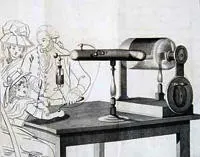
The library of the Physical Society includes many of the most important medical works of the late eighteenth and early nineteenth century. Matthew Baillie's The morbid anatomy of the most important parts of the human body (1797) foreshadows much of the work of Thomas Hodgkin in drawing conclusions about the course of diseases from autopsy evidence. Other works focus on certain therapeutics which were becoming popular during this period such as sea-water or electricity, including Richard Russell's A dissertation on the use of sea-water in the diseases of the glands (1753), and George Adams' An essay on electricity (1787).
Opium as a therapeutic features in John Brown's The elements of medicine (1795) in the translation of this work from the Latin by Thomas Beddoes. Brown's "excitement" theory of disease causation faded into obscurity, but his enthusiasm for opium found favour with such literary figures as Coleridge and De Quincey, the second edition of whose Confessions of an English Opium-Eater (1823) is included in the collection. Beddoes, who for a time was an associate of Coleridge, was a fascinating writer on medicine, whose most remarkable work, Hygèeia, or Essays moral and medical (1802-1803) is a combination of popular medicine and social commentary. Beddoes' partner in the use of nitrous oxide as a therapeutic was Sir Humphry Davy, the first edition of whose Researches, chemical and philosophical (1800 ) details the experiments which he undertook with Beddoes.
The transformation in obstetric medicine which took place in the eighteenth century is also represented; the collection includes William Smellie's A treatise on the theory and practice of midwifery (1779) and other lesser known works. The role of naval and military medicine in improving nutrition and in originating tropical medicine is disclosed in James Lind's A treatise of the scurvy (1757) and in Gilbert Blane's Observations on the diseases of seamen (1789). Both Lind and Blane were instrumental in altering the diet of sailors.
Noteworthy larger format books from the collection include a 1609 edition of the works of Galen; an English translation of the works of the pioneering French military surgeon Ambroise Paré; and copies inscribed by the author of Thomas Addison's On disease of the supra renal capsules (1855) and of Sir Astley Cooper's On the anatomy of the breast.
Journals
All the Guy's Hospital historical journals, including those of the Physical society, are now on the online catalogue. They cover the period from the mid-eighteenth to the early twentieth century and include titles on the natural sciences as well as medicine. Although the journals are predominantly British, some overseas journals, such as The Transactions of the Medical and Physical Society of Calcutta (1825-1845) and the Medical Repository (1797-1824), published in New York, are included.
Using Library Search
Records from all collections are available through King's Library Search.
Being signed in to Library Search gives the best functionality for searching and the homepage gives advice on how to narrow down your searches by using scopes and by filtering searches you have made. For full instructions please see both the Library Search homepage and also our 'Catalogues' webpage, available by scrolling down to the menu on the Special Collections homepage.
Using scopes
You can limit your search to Foyle Special Collections Library items by using scopes.
If you select the ‘Library Resources’ scope, only the print and ebooks, audiovisual material and journals held by the campus libraries and Foyle Special Collections Library will be retrieved in your searches
Using filters
For finding material related to specific collections or former owners, use the ‘Library Resources’ scope in the drop down menu and then filter by ‘Former owner’ in the Advanced search criteria to display records from a specific collection.
You can also use the Location drop down menu on the left hand side of the screen to identify items from specific named special collections.
Please do contact us for further advice on identifying material which will assist you with your studies.
The Archives of King's College London hold a significant amount of material relating to the history of Guy's Hospital Physical Society and a general Summary guide to the Guy's Hospital: Physical Society holdings has been published online.
Further reading
Andrew Baster. "The Library of the Guy's Hospital Physical Society", Guy's Hospital Gazette, 1984. H. C. Cameron. Mr. Guy's Hospital, 1726-1948. London: Longmans, Green & Co., 1964. [New Hunt's House WZ23. GUY ]
Bransby Blake Cooper. The life of Sir Astley Cooper, Bart. ( 2 vols.). London: John W. Parker, 1843. [Weston Education Centre WZ100. COO]
Christopher Lawrence. Medicine in the making of modern Britain, 1700-1920. London: Routledge, 1993. [Maughan Library KRA418.3 G7 LAW ]
Susan C. Lawrence. "Desirous of improvements in medicine: pupils and practitioners in the medical societies at Guy's and St. Bartholomew's Hospitals, 1795-1815", Bulletin of the History of Medicine ( 59 ), 89-104
Susan C. Lawrence. Charitable knowledge: hospital pupils and practitioners in eighteenth-century London. Cambridge: Cambridge University Press, 1995. [New Hunt's House WZ56. LAW]
Jeanne Peterson. The medical profession in mid-Victorian London. Berkeley: University of California Press, 1978. [New Hunt's House. WZ59 PET]
Nicholas Roe. John Keats and the culture of Dissent. Oxford: Oxford University Press, 1997. [Maughan Library PR4838.P6 ROE ]
R. Wall. "The Guy's Hospital Physical Society (1771-1852)", Guy's Hospital Reports, 1974, 123 [Wills Journals]